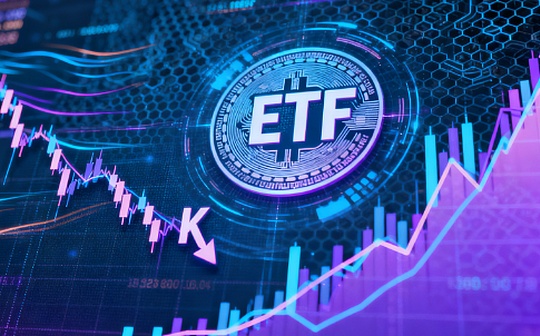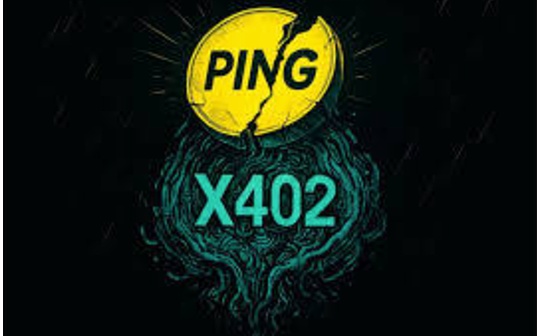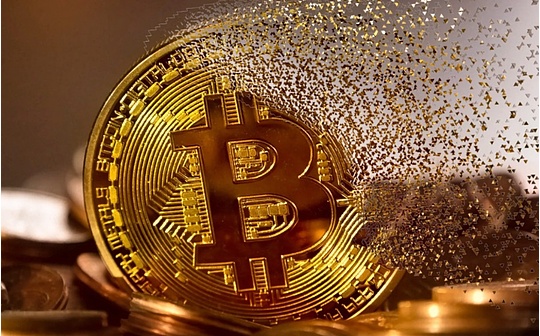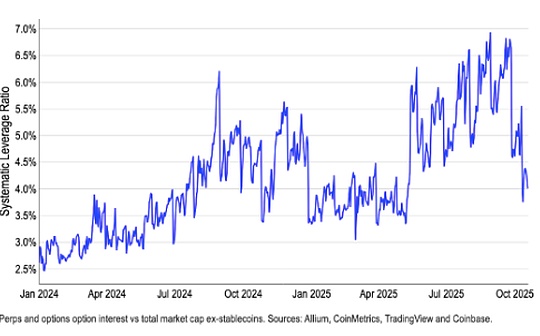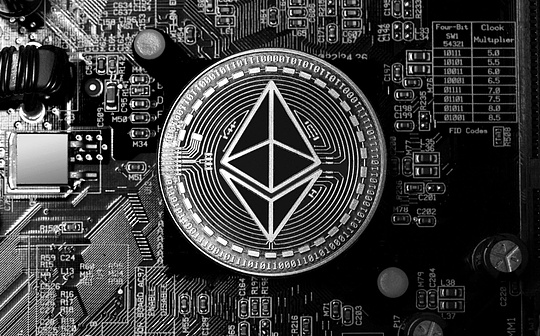
Author: ivangbi Source: lobsterdao Translation: Shan Oppa, Bitchain Vision
This article is divided into 3 parts:
-
The importance of proper communication with ordinary users and partners.The preface uses a common example and sets the context for the topic.
-
1-9-90:The second part discusses the 1-9-90 guide and my explanation.It can be widely used to guide any community.
-
The difficulty of coordinating communication among large groups and the possibility that it may not be needed in the later stages (Ethereum today).You can think of Part 3 as a sensational overview of the Ethereum debate over the past week, and that’s also part of the same issue.Is Ethereum suitable for 1-9-90?It is one of the problems that this part is being solved.
1. Preface: Common Mistakes between Developers and Holders
-
Holder: “Exchange, listing?”
-
Developer: “We are focusing on products and services now.”
-
Holder: “You don’t care about the community at all, go ahead and you!”
-
Dev: “You’re just a price gouger, go away!”
You’ve seen this before, right?That’s what happens in every project chat on Discord, Telegram and Twitter.I can assure you that both sides hate each other in this conversation.The developers believe that coin holders are a civilian who wants to quickly increase shipments.Meanwhile, coin holders believe that the developer is an elite bastard who builds castles in the air.
Both statements are true, but they are also wrong.They just can’t communicate.They speak different languages.The holders are just concerned about the value of their package, but do you think the developers don’t care?The developers are also very concerned.Whether developers lack commercial capabilities – is another issue, and we won’t talk about it for the time being.
PS: Please note that I do not worship either party because they are both right and wrong.It is a bad idea to support either side, and you need to see the middle ground.
1.2 Direct solutions to prevent negative emotions from spreading
-
Holder: “Exchange, listing?”
-
Response: “This question cannot be answered publicly at this moment, but it is of course an important question. You can participate in the discussion at <here>. At the same time, we are preparing to release some cool products, so pleaseThere >Send your comments on this topic, and hope you can raise it!”
The above holders may not participate further, but they will not cause trouble either.They desperately need a response, and they have the opportunity to go and give their opinions at the end of the day.Win-win!
Experienced people will understand that the responses they get are superficial, so you can’t overstate it.You need to direct people to some relevant and useful context so that you don’t sound as condescending as if you were talking to your kids.Again, simple shifting topics can work once or twice: it’s just a delay until you get the real answer.Repeated shifting of topics will eventually have negative effects.This strategy won’t work if the accumulated anger has reached its peak.In this case, you must give a true and long reply, otherwise you will accept temporary failure.
In WEB2, there are teams dedicated to social media FUD prevention.In the restaurant, there are trained staff to deal with the angry and drunkest customers.Why do you think the situation is different here?
Conceptually, no developers owe any debt to the holders (ethically I think they owe, but that’s another topic), but, no one owe any recognition or money to the developer.
You two, stop putting on airs.
1.3 Structural repair of root causes
Their goal is somewhat similar: tokens rise.However, their paths to achieving their goals are different, so their timelines are also different.Developers need high project value to have sufficient liquidity to exit.Also, believe it or not, some developers want to create something cool!On the other hand, the holder can sell as long as he has a $100,000 order depth.Therefore, although their incentives are generally consistent, their working time ranges are different.I know this is obvious.
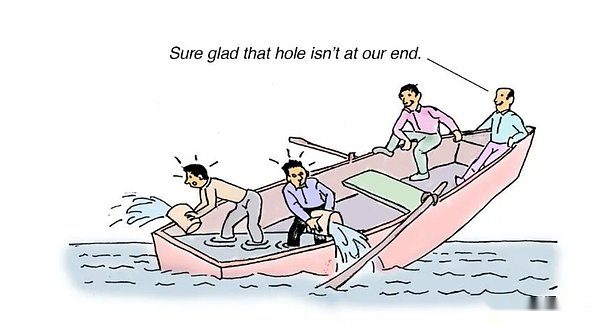
Nevertheless, the best way to achieve both of their goals is to work together.Developers need many holders, and many holders need excellent developers to build.They can’t coexist with each other because if they try to coexist… you end up with the market today.90% of people participate in meme coin gambling PvP, 1% are elite liars, build a sky castle and spend the summer in Switzerland, right?!
PS: In some cases, developers make false promises, or holders become negative for any reason because the market is booming.In this case, neither side can do anything.You need to unite with your core supporters, reach agreement when your vision must be renewed, cheer up, and work hard.If you make some progress and don’t go bankrupt, you’ll become stronger.In a situation of complete failure, only cruel honesty is effective.
So, what exactly is 1-9-90?What does it have to do with all this?I didn’t come up with this concept myself, and even Wikipedia has pages about it.I’m not sure if my explanation is really what Wikipedia suggests, but I found it worked for years.Anywhere.
2. 1-9-90 Community Construction
To simplify it in an encrypted environment, you can think of it as:
-
1% are developers, builders, teams and creators.
-
9% are writers, funds, researchers and angel investors who enthusiastically observe the field and comment.Not a real team, nor a passing rookie.
-
90% are random traders and speculators who never actually read the document.They read the title, buy and trade coins, and hold cryptocurrencies – but they don’t bother with researching the problem.Just Yellow Pages enthusiasts and traders.They are not stupid, they just don’t want to marry any investment.For them, fundamentals usually don’t exist, they just want charts.
All of these groups are important.If they are isolated, they will slowly die out.
Speculation stimulates capital markets and investment, which in turn provides developers with construction resources, and then adds a foundation for pure speculation, etc.It’s like a living organism.Cut off a part and it will wither.
Don’t be too proud!
2.2 1-9-90 Why is it effective?
We cannot know everything, and we cannot keep up with everything.We may not like over-generalized statistics and well-crafted pushes on Netflix, but we can’t survive without them.If there are multiple choices for everything we allow to encounter, our brains will explode.Especially in startups.We want others to do these tasks for us.Those who go digging a bunch of garbage can find more refined gems, but sometimes it can be with the flow.
-
Why do you still follow what those 9% say?——These funds, researchers and angels are seen as trustworthy in many cases.They have been around for years, so they won’t succumb to a cheap scam.Or at least that’s hope.Therefore, traders and gamblers are more likely to choose assets with the most reputable supporter group behind them.
-
Why do the 9% bother to act as screeners?——Because the better they screen, the more money they make.And in the long run, they may attract more followers.If you can pick gems early, you will get a better valuation and you can also show others that you have the skills to become a gem hunter.
9% is the adhesive between 1% of hardcore autistic developers and 90% of deal holders, who must accept a more refined narrative.If you were to specify the 9% effect, I would say it is organic marketing and some enthusiastic introduction to BD.Essentially injecting reputation and charm into early unknown projects.
2.3 1-9-90 What is the stage like
These 3 factors usually do not align at the same time, and this will only occur in a bull market.The goal is to always have 2/3 aligned, which can be done.By definition, 1 and 90 are unlikely to align, because the key to translating news into 90 is these 9 factors.So you have to always start with 1+9 and then start working from there.
The exception is 1+90, because you are building something completely easy to use for 90.That would be memecoin, click games on Telegram and similar phenomena.In these cases, booting is not required to be 9.However, when these things go online, things change and require some sustainable coordination, but this coordination is not necessary for guidance because everything happens in the hype.
This would be a typical startup project consisting of teams, angel investors and community holders.The team (1%) starts something, then (9%) pushes it further and makes it visible, and then the trader-holder (90%) accepts the narrative and moves forward.
-
1% of developers start researching an idea and start making something.
-
They will consult with friends, angels, capital allocators, researchers, etc.These 9% are excited about some of these ideas.
-
Then, for some reason, the ideas were adopted by many 1% and 9% of participants and somehow entered 90% of participants.
This is the usual secret and direction for every company.While this does not guarantee success, this approach usually takes the first step.If you already have a network, it’s usually easy to go from 0 to 1 because whatever you impose on them, they will accept and support it.
A bad example is Worldcoin, which is a weird product and its token strategy is weird (even though they have how cruel and dystopian they have), but a lot of “9” support it and just because of the founder’sNetwork and accept it into their communities.
2.4 No 9 problem
You don’t usually want to be an exception to the rules, take the 1+90 route, because 9 focuses more on long-term development than 90.If you end up having only a hype-driven community without fostering 9, you may have only 1 left during any market turmoil.This is the problem with hyping projects only.It’s a good bootstrap strategy, but ultimately, you have to find your 9, or turn your 90 members into 9.You can’t live without preachers and those who are willing to stick with you.

Do you still remember the secondary market sales of “fair issuance” from 2020 to 2021?Some projects do not have any sales at startup, only contributors and/or DAO parts.After a few weeks or months, they need funds to maintain and further establish the brand/aggregation.Therefore, they conducted secondary market OTC transactions.The prices of these transactions may vary, but the dynamics have not changed.Eventually, although they started at 1+90, they eventually had to find their 9.
Another reason is related to people’s perception.If I were a researcher, I went into the chat room and saw only giveaways and airdrops—I would immediately think of “it’s a scam.”And most of the time I’m right.This is a time-saving over-generalization method, but it does work.therefore,You usually want to start lean first, create technical content to grow 1%+9%, and then adopt a larger coverage strategy.Otherwise, you might attract 90% of people, creating too much noise to attract 9% of the outside, or convert any of your 90% into 9.Be careful!
This is especially dangerous for those who want to get tokens quickly and launch IEO quickly.Fortunately for these founders, most of the time these are made and set up like scams, so they don’t care about community building anyway.
Technology → Angel Investor → Hype
Yes, this can indeed become some sort of gatekeeper.But without malice, it can save everyone time and allow real community building.Alternatives exist, so just check what the strengths of the team are.
2.5 Real-life examples: Ethereum conference
The most obvious example of 1+9 interactions in the real world is the Ethereum conference.Many developers came here to talk to funds and angel investors looking for alpha, and some projects were born.Investors No. 9, i.e. those funds and angel investors, may also like crazy dreams and ideas, but at the end of the day, they want to make money (more than 1 investors), so they need to verify anything with Investor No. 90.How much is a given narrative now or how much may be needed later.
1+9 does force people in the 90s to accept it, but it is harder than expected.It’s hard to do this artificially.You need some fundamentals and numbers to support your claim: It’s not always easy.You can think of Celestia as an example of a well-crafted slightly compulsive niche from a valuation point of view.I don’t criticize it at all, they’re very savvy, but it’s not easy to push a new story to over $10 billion and keep it going for months.No one knew about DA in the 90s, and they certainly didn’t think it was a $10 billion market.
In any case, problems arise when the supply of 9 is too high.This happens when they only spend time with 1 and forget to verify their reality with 90.Then you end up in a closed-door orgy with the developer elite who are not good for anyone.It is important to focus on reality, otherwise everyone will suffer.
Permanent optimism and dreams are great, but excessiveness is not great.
2.6 How to maintain 1-9-90 alignment after bootstrap phase
Because nothing will rise forever, even if you have a perfect 1+9, you will have times when confidence and consistency in the future are broken.In those times, you need to find the reason.Is it the team that stopped working or is the market just turning red?Are developers working, but they are building some castles in the air that even 9% of people can’t understand?
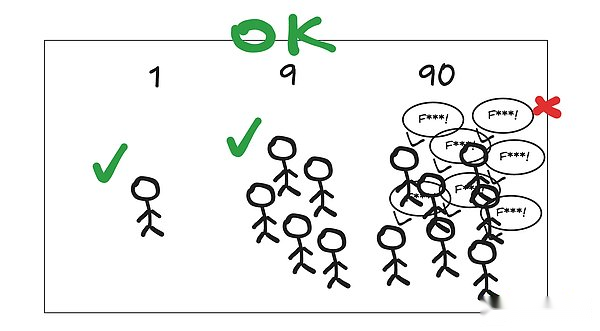
These are some questions that can check emotions.If the team is working hard and the narrative is complete, it is likely to be 1+9 and is consistent.So they need to build through the red market and then there is no problem.There is nothing you can do here.
In times of crisis, you should simply chat with your partners to get them aware of some new details and reaffirm their biases when needed.No one has completely trusted anything new from the beginning, but time creates power in the brand and vision.Cultivate it first, and then it will happen naturally.This can actually be applied to trading too: when all tokens are red during the bear market, MATIC is the only token that has risen a little bit, and traders begin to imitate it as a “green haven for the whole market.”Fr!
You can never confuse 9% and 90%.This means developers will face complete alienation.You need the core team to talk to angels and researchers, you need the angels and researchers to know what to convey to 90%.By the way, this is not a pyramid of some kind, it is just the way news spreads from person to person.This is a fact.
“Action is better than words” and “best technology is better than words” are also correct.The opposite happens when there are too many (good) bad words or bad marketing of inferior technology is good.Both humans and the market are irrational.
2.7 Checks and balances between groups
-
1% of people: They may be too confident, too elite, and have a high opinion of themselves.The more capital they get, the more they get away from reality.Their ideas are too optimistic.
-
9%: Research should be done, but in the end, only some snippets (like me).The problem is that they have caused themselves too much trouble and waste the founder’s time explaining things to them—or else, they may be full of misstatements and thoughts.These people tend to say a lot because for many of them it is their job to give their opinions.It’s easy to become hypocritical.
-
90% of people: There is nothing wrong with it!They take all risks and they get the least chance.Of course, they have the lowest patience and survivability, but that’s because when developers decide to betray and take cash, they don’t have a gold buffer.
3. Ethereum: Vitalik vs. DeFi vs. EF.
What happened in the past few days is that many people are angry with each other.There is nothing unusual in itself; people are just confused and can’t find a way to express it.They have been working for over 3 years since the last round, but no new sales or users have come to buy their bags, so everyone is frustrated.This is just a fact.I didn’t come up with a reason or a solution – that’s what another post is about.Just state the status quo.
Amid all this, some people try to have proper discussion.For example:
-
Vitalik (1%) expressed his concerns about DeFi.It’s well written, and there’s more to this post.He may be too addicted to his overly grand vision, but he is polite and provides context.He wants to think about bigger goals and inspire others to go beyond what we see today, not to be hindered by what we have, and to look forward to the future.This is what it means to have a vision.He doesn’t need to be right either, he is not the owner of Ethereum.
-
The Ethereum Foundation (1%) was silent on the sale for several years, and then Aya made a somewhat insensitive response.It’s not because she said something bad or wrong, but because EF is too far from everything the average people deal with, so she “didn’t understand the situation.”But EF has maintained a lot of transparency in the past and present.
-
The founders of DeFi (1-9%) are confused because despite their strong strength and don’t care about the support of outsiders, they don’t mind someone patting their shoulders, at least not slamming finance step by step like Vitalik used to joke.Maybe he did too much and ended up affecting people.
Communication barriers are occurring.The Ethereum Foundation and brain developers are too focused on the future, so it sounds like they don’t care about today’s issues.Although they care, they just go further in thinking.This is difficult for the other party to understand because they don’t know much about all the brain and thinking processes.
The final result is as follows:
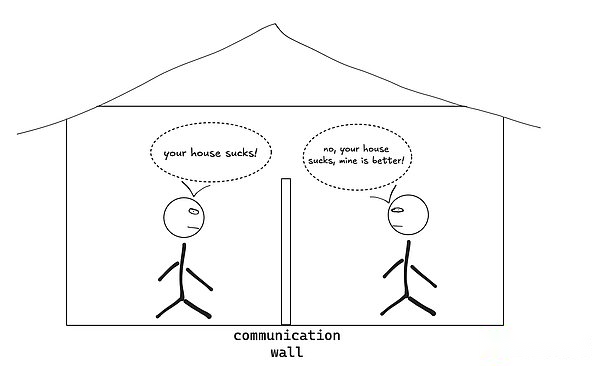
3.2 Are there structural problems with 1, 9 or 90 here?
As mentioned earlier, any criticism is conceptually valid, depending on the root cause.What’s the reason here: Are the developers estranged, or are people in the 90s not sure what happened, or are people in the 90s complaining about the price?This is the problem.
Let’s start with 1%.
Are developers working?Yes.Are they involved in public discussions?Yes.Do different development teams work in different jobs at the same time?So.Are there activities and hackathons to attract new developers?So.Since scalability has been partially resolved, is there a structural approach to address L2 fragmentation?So.So, I don’t think there is any problem with 1%.
Let’s quickly check that 90%.
Well, they know ETH is a huge asset.They know the market may have red.There is no doubt that they are confused by how many of these 9 people themselves are confused.Unreasonable panic can lead to actual structural problems.
Now there is only 9% left.
In my opinion, the crying 9 we see is the top 9 turning into sensational traders.There is nothing wrong with that, just not seeing them as 9 anymore.They no longer dig out a page of content, they just read the title.Confusing them with 9 can lead to you thinking there are structural issues.If you want to double-check this, ask the developer.If the developer confirms, there is a problem.

No intention to disrespect, but if you look at L2 and conclude that “fragmentation is killing ETH, it’s all over” while ignoring all the research on scalability – that’s the skill issue.
3.3 Are efforts or issues being ignored?
9 The reasons for being confused are obvious and easy to understand.Ethereum is constantly developing and has had an L2 roadmap for many years, resulting in a split in its development path.When you adopt modularity, you will have problems reconnecting the parts, which is normal.As long as the goal (scalability, larger platform) is effective, it can be explained.
So if someone feels pessimistic in the short term, I understand, but saying “Ethereum is dead and does nothing to do with scalability” is an intellectual lie.Those 9 who are involved are just selling their alternatives, are turning into the 90s.Watch out for those sensational Twitter.
I’m not protecting myself, because this article won’t affect anyone.I’m happy to see and accept the existence of structural problems, but I can’t see any argument except “EF members get some advice” and “EF sells some ETH with less than 0.1% of the total circulating supply”.You can do better.
But anyway, should we adapt to 9 as stated in the travel guide?
I further point out that the answer is no.This is no longer necessary and impossible.
3.3 Separation of church and state.Forgot leadership?Forgot 9.
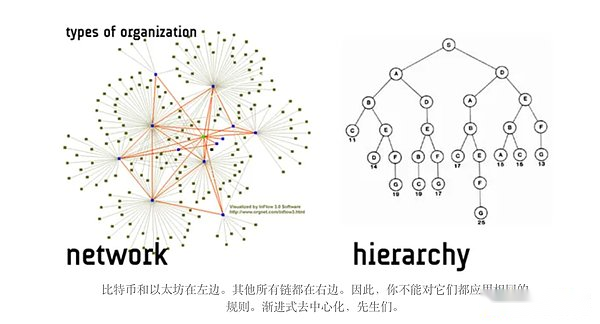
At this time, Ethereum is obviously in the network stage.The requirement to “adjust the roadmap” is a misunderstanding of the purpose of the entire operation.This doesn’t mean there is no need to try macro adjustments, but now they happen temporarily.If you see the first image, think of the main orange connection points as the main Ethereum team: clients, large funds with research departments, ecosystems of interconnected protocols, and more.As long as they sometimes coordinate with each other, that’s fine.So ask yourself: If you don’t know what the Orange people are doing, maybe you haven’t delved into it.So it’s a skill issue, not an ecosystem issue.Don’t be self-righteous.

All these discussions, criticisms, etc. should happen.The difference this time is that too many formerly decent actors have become hardcore messians and cause trouble.This is especially true for some funds’ GPs (you know who I’m talking about).Mainly those who promote their own L1 stinky bets.If they think other L1s are better, they support them, wait, that’s fine.However, doing so at the expense of fictional fugazi argument is intellectual suicide.Like this:

This is not the first time we have seen large ecosystems come to this point.At this time, fragmentation, different misalignment of interests, etc. – is indeed right in front of us.butInstead of turning to communism and centralization roadmap, perhaps a better path is to elevate all this to a non-frailty state.Putting aside fancy words, these are not important.DeFi, social, whatever it is—Vitalik’s point of view, Ethereum Foundation’s point of view, or any cult leader’s point of view.
So what should I do?
-
Vitalik may be overly elite and don’t want use cases that don’t exist yet or never exist.People want more tangibility, and that’s what DeFi brings.
-
Of course, the Ethereum Foundation can be more transparent.
-
The narrative of Ethereum has become multifaceted, so it is difficult for 9 to understand a clear agenda, so they are confused.
…But the answer is: It doesn’t matter.
3.4 You can’t and no longer need to be fully aligned.
How many cabals are there on Ethereum at the moment?Client team?Venture capital fund?Canvassing group?The answer is: a lot.When was the last time you needed EF approval or Vitalik’s blessing to build anything (not related to the core agreement)?——Never.
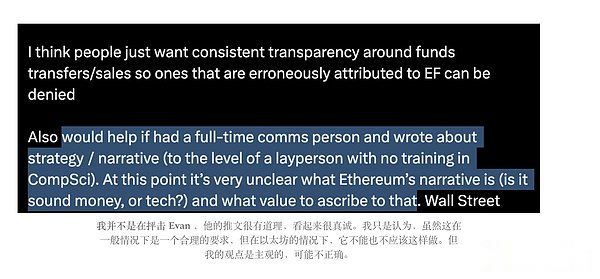
The Ethereum Foundation will be disbanded tomorrow, and Vitalik can take a yacht to sabotage—it doesn’t matter.Even if transparency is a problem, even if Vitalik is wrong, who cares?Ethereum is at or should already be in a stage where the core initial group is irrelevant.So, attempts to turn it into some kind of “Ethereum culture problem” like below shouldn’t be true.Culture is an open level playing field, not a central point of view.Bitcoin has experienced similar tests before, so it is a practical test of the intensity of the argument.
Based on my experience with my contacts since 2017 in the cryptocurrency space, none of them has received any meaningful support or funding from Vitalik.He was furious about ICOs during his boom, and he was furious about DeFi in 2020 – it’s OK.He doesn’t need to be right.He had to be right in 2015, 2017 and later on building a community and being a visionary person…but at this point, some formed a coalition against EF.This is very good!
No DeFi founder needs his blessing or EF’s support.In fact, it was built from the hatred on their side.However DeFi survived and grew, so why should you ask for any blessings now?One thing to note is that as long as they don’t make some core protocol changes to make DeFi less available, everything will be fine.For example, the gas costs of some DeFi critical operations.Basically chasing their grand vision at the expense of DeFi’s availability and growth.
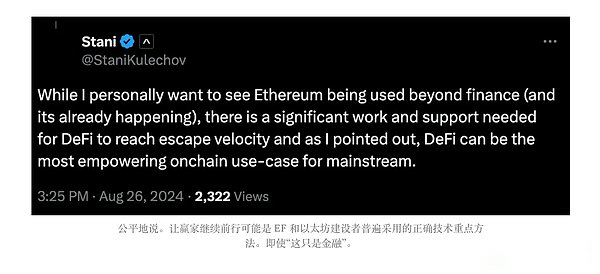
In this way, the sensationalists can rest assured that they will not make small arguments into big problems.
3.5 Other things to consider
-
No matter what Vitalik says, people get angry.Unless they have reasonable criticism, responding to angry Twitter users can sometimes create negative emotions.But if they pick every word because of resentment, let them go.However, it is still good to understand the situation in the house.Vitalik is not bad at this, but it is not always the case.
-
The Ethereum Foundation has built a lot of transparency, but can do more.It would be fine if they didn’t, because almost no one interacted directly with them.Therefore, this is not creating systematic problems in unnecessary places (9s forces this narrative to become systematic).Maybe look at other players growing in the ecosystem.
-
Other foundations spend more and let the foundation president manage the venture capital fund (Solana), and even let the foundation buy almost meme coins (Avalanche).Again, it’s both good and bad, and I’m not trying to say “they did something worse, so it’s okay to do something bad”.No.I’m just saying that those trash can workers in other chains should probably solve their problems before ranting.
So far, I hope you understand the importance of correct information delivery and communication.These basics go beyond original technology and extend to general community building and your positioning with other partners in the field.
As for Ethereum, there is no longer a need for step-by-step guidance.There is no more leadership.There is no more top-down centralized roadmap.So, let people fight and exploit each other, and support the free market…
And be careful who you believe.Type 9 people are often type 90 people.The only exception is that the type 90 doesn’t lie to their intentions, while the type 9 likes to peddlers of scams.

